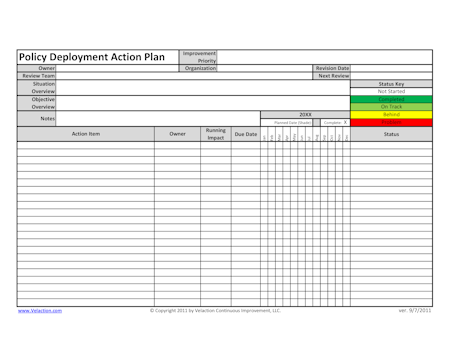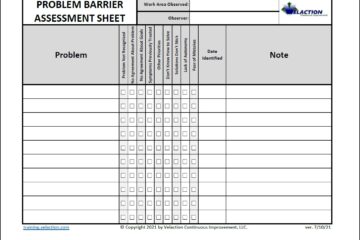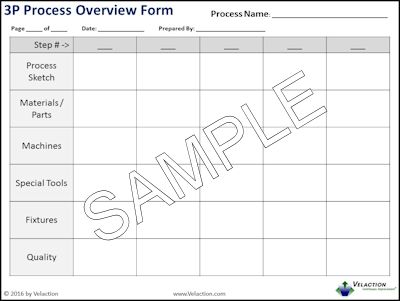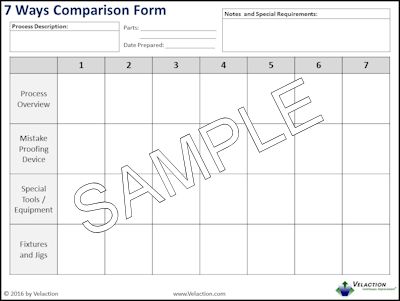Policy Deployment Action Plan
Policy deployment is a process of turning the strategic goals of an organization into actionable tasks at the frontline of an organization. This systematic approach to leadership clearly defines the path to success.
One of the tools used in effective policy deployment is the Policy Deployment Action Plan.
Get Our Policy Deployment Action Plan for FREE
Each and every improvement priority should have an action plan associated with it. The policy deployment action plan serves a vital role in creating an effective strategy. It keeps improvement targets from being pie in the sky goals. Plus, they act as a reality check when committing to improvements. As the plans get developed, the amount of work needed to achieve the goals becomes apparent. Because of the methodical nature of assigning responsibilities in the action plan, it is obvious when a person is overcommitted. If people are stretched too thin, there is no way that they will hit their milestones, and the company will miss on its strategic goals.

Every bottom level improvement priority must have an action plan associated with it. If there are two closely linked priorities, they may be combined if it makes sense, provided that the owner is the same for both. Do not allow a single action plan to have multiple people who own it, or the responsibility will be diluted and there will be a potential for conflicts. That is not to say that there should not be coordination between people, but the buck should stop with a single person.
Steps to Filling Out a Policy Deployment Action Plan
- Fill out the header information. Note that the improvement priority should match what is shown on the PD Matrix.
- Note the latest revision date of the action plan.
- Every action plan should always have a review scheduled on the calendar. Mark that date on the “Next Review” space.
- List the action items. Think “big picture” here, not the step-by-step process. When the action plan is developed, you will probably only have some broad brushstrokes of what needs to be done.
- Assign the owner of the task in the “Owner” column. Use specific names, not titles, and make each have only a single person.
- Note the running impact of the changes in the appropriate column. Not all projects will make incremental improvements. Opening a new facility, for example, probably won’t yield benefits along the way. The steps taken to reduce parts shortages, on the other hand, may lead to improvement throughout the project. Make an estimate of when you think benefits will be seen to be able to compare to reality.
- Mark the calendar with a gray block in the month the step is expected to be finished. Mark the month with an ‘X’ when it is done.
- Note any status issues in the status box. Highlight the status box with the appropriate color to show which stage the step is in at a glance.

Words of Warning for Policy Deploymant
- Be careful about making significant changes to a PD Action Plan. Improvement priorities, due to the methodical approach of policy deployment, are tightly connected. Changes in one can disrupt the strategic plan significantly.
- Don’t make results fit the plan. Make a plan to achieve the desired results. If the plan can’t deliver on the improvement target, your work is not done.
- Try to keep the action plan to a single page, if possible, but longer ones are acceptable for significant improvement priorities. Use addendums to flesh out details, if needed.
![]()
If you are already doing policy deployment in your organization, try integrating Velaction’s action plan into your PD process.
If you are not already doing PD, the next step is a more considerable challenge. The first step is to identify and close training gaps in policy deployment. (Note: We offer PD and leadership training to help with this.) When the team is trained, begin using PD to run the organization. The PD Action Plan is part of that process.





0 Comments